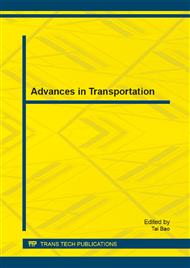[1]
Airey, G. D. 2002. Rheological evaluation of ethylene vinyl acetate polymer modified bitumens. Construction and Building Materials 16: 15.
DOI: 10.1016/s0950-0618(02)00103-4
Google Scholar
[2]
Airey, G. D. 2003. Rheological properties of styrene butadiene styrene polymer modified road bitumensq. Fuel 82: 11.
DOI: 10.1016/s0016-2361(03)00146-7
Google Scholar
[3]
Carrera, V., García-Morales, M., Navarro, F. J., Partal, P. & Gallegos, C. 2010. Bitumen chemical foaming for asphalt paving applications. Industrial and Engineering Chemistry Research 49 (18): 8538-8543.
DOI: 10.1021/ie101136f
Google Scholar
[4]
Carrera, V., Partal, P., García-Morales, M., Gallegos, C. & Páez, A. 2009. Influence of bitumen colloidal nature on the design of isocyanate-based bituminous products with enhanced rheological properties. Industrial and Engineering Chemistry Research 48 (18): 8464-8470.
DOI: 10.1021/ie9004404
Google Scholar
[5]
Changqing Fang, R. Y., Ying Zhang, Jingbo Hu, Min Zhang, Xinghua Mi. 2012. Combined modification of asphalt with polyethylene packaging waste and organophilic montmorillonite. polymer testing 31: 6.
DOI: 10.1016/j.polymertesting.2011.11.008
Google Scholar
[6]
David Whiteoak, J. R. 2003. Shell Bitumen Handbook. Edited by 5. UK, London: ICE Publishing.
Google Scholar
[7]
Fuentes-Audén, C., Sandoval, J. A., Jerez, A., Navarro, F. J., Martínez-Boza, F. J., Partal, P. & Gallegos, C. 2008. Evaluation of thermal and mechanical properties of recycled polyethylene modified bitumen. polymer testing 27 (8): 1005-1012.
DOI: 10.1016/j.polymertesting.2008.09.006
Google Scholar
[8]
Guian Wen, Y. Z., Yinxi Zhang, Kang Sun, Yongzhong Fan. 2002. Rheological characterization of storage-stable SBS-modified asphalts. polymer testing 21: 8.
DOI: 10.1016/s0142-9418(01)00086-1
Google Scholar
[9]
Hailong Jin, G. G., Yong Zhang, Yinxi Zhang, Kang Sun, Yongzhong Fan. 2002. Improved properties of polystyrene-modified asphalt through dynamic vulcanization. polymer testing 21: 8.
DOI: 10.1016/s0142-9418(01)00135-0
Google Scholar
[10]
Jian-Shiuh Chen, P. E. M. -C. L. a. M. -S. S. 2002. Asphalt Modified by Styrene-Butadiene-Styrene Triblock Copolymer: Morphology and Model. Journal of Materials in Civil Engineering 14 (3): 224.
DOI: 10.1061/(asce)0899-1561(2002)14:3(224)
Google Scholar
[11]
Kasrai, M., Bancroft, G. M., Brunner, R. W., Jonasson, R. G., Brown, J. R., Tan, K. H. & Feng, X. 1994. Sulphur speciation in bitumens and asphaltenes by X-ray absorption fine structure spectroscopy. Geochimica et Cosmochimica Acta 58 (13): 2865-2872.
DOI: 10.1016/0016-7037(94)90120-1
Google Scholar
[12]
Papirer, E. & Fritschy, G. 1981. Modification of the surface properties of bitumen and asphaltenes following treatment with sulphur at 140 °C. Fuel 60 (8): 670-672.
DOI: 10.1016/0016-2361(81)90216-7
Google Scholar
[13]
Routes/Roads. July 1999. Modified binders, binders with additives and special bitumens. World Road Association, PIARC No. 303, III.
Google Scholar
[14]
Yousefi, A. A. 2002. Rubber modified Bitumens. Iranian Polymer Journal 11 (6): 303-309.
Google Scholar


